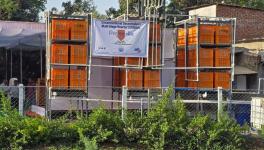India’s Clean Energy Push: Protests Intensify in Kutch over Windmill Plant on Forest Land

As India makes its clean energy push to reach its 175 Gigawatt targets before 2022, wind power will account for 60 Gigawatt of the total generated power. As India aims to create a faster push in the process local communities, livelihoods and ecosystems run the risk of being bulldozed under these ambitions. The villagers of Sangnera village are resisting the setting up of newer wind mill projects on the 500 square kilometers of sacred land by corporate giant Suzlon. The residents state that the setting up of the plants has meant deforestation, loss of community grazing land and a threat to livelihood.
Following the second wave of Covid, the past month has seen a renewed attempt by Suzlon to put up two more windmills. The villagers, including women and youth, have been regularly stopping the company vehicles from entering the forest, which in turn has led to heavy police presence in the area. On Friday, August 6, villagers occupied the land allotted to the company to register their protest against setting up of the latest plants. The movement is gaining momentum, and over 13 organisations and civil society groups have joined the resistance.
The protests have been ongoing for the past few years as the conversion of Kutch into a major clean energy hub has taken shape. The Sangnara forest is part of the sacred grove where five villages have their places of worship with a huge diversity of threatened flora and fauna including Chinkara, Wolf, Caracal, Ratel, Hyena, Desert Cat, among others. These communities have maintained and protected this forest for the past 500 years.
The first wind energy turbine was put up in the forest 5 years ago by Suzlon. Residents state that this led to the destruction of hundreds of trees, flattening of hills to create access for the machinery, fans and transmission cables. All the birds and wildlife deserted the area, scared by the consistent noise of the fans and machinery. Fifty more windmills were approved by the administration in the forest.

Speaking to NewsClick, Pankaj Joshi, an ecologist based in Bhuj, Gujarat, said, “The communities residing here are farmers and pastoralists, this is a forest area and a wilderness area and the fight is to preserve the ecosystems. The windmills are allocated in the area of what can be termed as a dense forest which is currently under the revenue department. There are over 40 points of windmills with more than 4-5 companies in this region. Which has meant high scale deforestation while the case is ongoing in the NGT, the protestors are trying to establish that this area needs to be included under deemed protests.”
Joshi added that despite the orders being pending in the court, an effort is being made to set up machinery and renew the projects. The state government had allotted land to a private company in 2015-16 to install 11 windmills in Sangnara. Three of the 11 locations were later cancelled due to technical reasons while the company installed windmills at six locations and laid foundation of one more windmill at Vadvalu Talav area.
Shankarbhai, a village leader said, “The government and companies are already telling us we are obstructing ‘development’; soon they will say we are terrorists and anti-nationals! We are not afraid as we are not doing this for any selfish gains; it is for the voiceless wild animals and nature.”
Kutch has become an epicenter of wind and solar energy exploitation zones, and in the past few years thousands of windmills have been put up by energy companies. The NTPC through its renewable energy arm, will construct what would be India’s largest single local solar power park of 4.75 Gigawatt in Kutch. However, this expansion of clean energy projects have not focused on local concerns and land conflict. Most projects under India’s ambitious energy transitions require vast tracts of land, these tracts are often lands occupied by communities which the government deems “unused”, such as the gauchar land of the farmers of Sangnera. Mongabay states, in November 2020, the Indian government’s Ministry of New and Renewable Energy (MNRE) made public a concept note on “Development of wind parks/wind-solar hybrid parks” identifying about 10,800 square kilometres of land across seven states to develop wind parks or wind-solar hybrid parks totalling about 54,000 MW. The proposed policy was, however, silent over concerns related to the environment, land and communities even though it may land up impacting projects worth billions of rupees.”
Get the latest reports & analysis with people's perspective on Protests, movements & deep analytical videos, discussions of the current affairs in your Telegram app. Subscribe to NewsClick's Telegram channel & get Real-Time updates on stories, as they get published on our website.
























